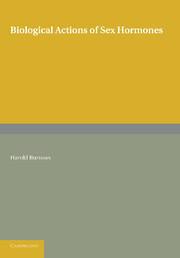Book contents
- Frontmatter
- CONTENTS
- PREFACE
- PART I GONADOTROPHINS
- PART II GONADAL HORMONES
- PART III ANDROGENS
- PART IV OESTROGENS
- CHAPTER XI Oestrogens
- CHAPTER XII The Action of Oestrogen on the Embryonic Gonads. and Miillerian and Wolffian Systems
- CHAPTER XIII The Action of Oestrogen on the Anterior Lobe of the Pituitary, and on the Gonads after their Differentiation
- CHAPTER XIV The Action of Oestrogen on the Accessory Genital Organs after their Differentiation, with a special reference to inguinal hernia
- CHAPTER XV The Action of Oestrogen on the Accessory Genital Organs
- CHAPTER XVI The Action of Oestrogen on the Accessory Genital Organs
- CHAPTER XVII The Effects of Oestrogen on the Mamma
- CHAPTER XVIII Factors in the Causation of Mammary Cancer
- CHAPTER XIX The Effects of Oestrogen on Connective Tissues and Skin
- CHAPTER XX The Actions of Oestrogen on organs other than those considered in earlier chapters
- PART V PROGESTINS
- PART VI SEX HORMONES OF THE ADRENAL CORTEX
- APPENDIX
- REFERENCES
- GLOSSARY
- INDEX
CHAPTER XI - Oestrogens
from PART IV - OESTROGENS
Published online by Cambridge University Press: 05 June 2016
- Frontmatter
- CONTENTS
- PREFACE
- PART I GONADOTROPHINS
- PART II GONADAL HORMONES
- PART III ANDROGENS
- PART IV OESTROGENS
- CHAPTER XI Oestrogens
- CHAPTER XII The Action of Oestrogen on the Embryonic Gonads. and Miillerian and Wolffian Systems
- CHAPTER XIII The Action of Oestrogen on the Anterior Lobe of the Pituitary, and on the Gonads after their Differentiation
- CHAPTER XIV The Action of Oestrogen on the Accessory Genital Organs after their Differentiation, with a special reference to inguinal hernia
- CHAPTER XV The Action of Oestrogen on the Accessory Genital Organs
- CHAPTER XVI The Action of Oestrogen on the Accessory Genital Organs
- CHAPTER XVII The Effects of Oestrogen on the Mamma
- CHAPTER XVIII Factors in the Causation of Mammary Cancer
- CHAPTER XIX The Effects of Oestrogen on Connective Tissues and Skin
- CHAPTER XX The Actions of Oestrogen on organs other than those considered in earlier chapters
- PART V PROGESTINS
- PART VI SEX HORMONES OF THE ADRENAL CORTEX
- APPENDIX
- REFERENCES
- GLOSSARY
- INDEX
Summary
General considerations. Sources, metabolism and excretion of oestrogen. Gradients of responsiveness. Reversibility of effects.
General Considerations
Definition and Terminology. The term ‘oestrogen’ denotes any substance which will induce cornification in the vagina of the adult mouse like that of natural oestrus. The meaning of the word ‘oestrin’ is not so easy to define exactly, or to define at all without a background of biological history. Apart from knowing that the sexual functions of the female depend on the ovary and are not controlled through its nervous connections (Knauer, 1900), our recognition of the hormonal basis of ovarian activity began with the observation by Marshall & Jolly (1905) that oestrus could be induced in spayed dogs either by the injection of extracts of ovary removed from another dog during oestrus or by implanting oestral ovaries into the peritoneum. These workers recognized that the ovary produces two different hormones, and that the secretion which causes oestrus is different from that formed later by the corpora lutea. A few years later Adler (1912) reported that oestrus could be brought on in guinea-pigs by intravenous or subcutaneous injections of extracts or press-juices obtained from whole ovaries or from corpora lutea. The next great advance was that of Allen & Doisy (1923, 1924), who discovered that liquor folliculi from the sow's ovary caused oestrus-like changes in the rat's vagina. The hormone thought to induce these changes thereafter came to be known as theelin, oestrin or folliculin. The active principle was at that time a hypothetical substance which could be recognized only by its biological effects. Later, the isolation of the hormone in crystalline form by Doisy, Veler & Thayer (1930) and also by Butenandt (1929), working independently, narrowed the meaning of the term oestrin, as used by British workers, to the single well-defined chemical compound now known as oestrone. This would not have led to terminological difficulty if other naturally produced oestrogenic compounds, including oestradiol, oestriol, equilin and equilenin (Fig.5, p. 104), had not been identified later.
- Type
- Chapter
- Information
- Biological Actions of Sex Hormones , pp. 251 - 270Publisher: Cambridge University PressPrint publication year: 2013

